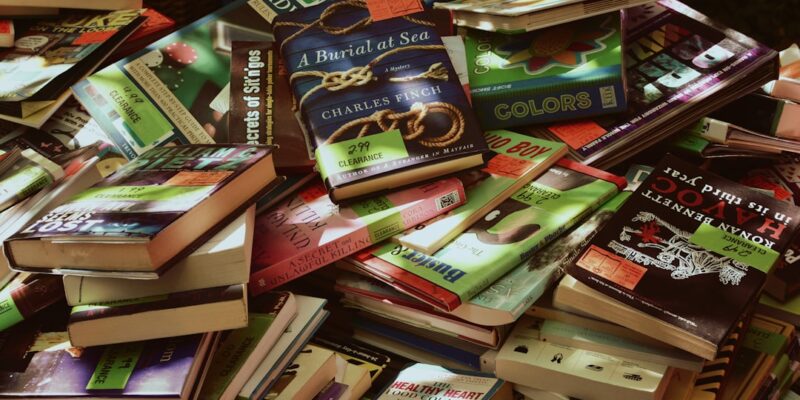
From Page to Screen: Famous Books as Films
Books and films have always had a close relationship, with many beloved stories making the transition from page to screen. This connection between the two mediums is rooted in the power of storytelling and the desire to bring these stories to a wider audience. Books provide a rich source material for filmmakers, offering well-developed characters, intricate plots, and vivid settings that can be visually brought to life on the big screen.
The reasons for adapting books into films are varied. For one, books often have a built-in fan base, with readers eagerly anticipating the chance to see their favorite stories come to life. By adapting a popular book into a film, studios can tap into this existing fan base and generate buzz and excitement around the project. Additionally, books offer a wealth of material that can be condensed and reimagined for the screen, providing filmmakers with a solid foundation on which to build their visual storytelling.
Key Takeaways
- Adapting a book into a film is a challenging process that requires careful consideration of various factors.
- Classic novels like “To Kill a Mockingbird” and “The Godfather” have become iconic films that have stood the test of time.
- Contemporary novels like “The Hunger Games” and “Gone Girl” have become blockbuster hits that have captivated audiences worldwide.
- Casting the right actors for the role is crucial in bringing the characters to life and creating a believable story.
- Directors play a vital role in translating the author’s vision onto the screen and bringing the story to life for the audience.
The Challenges of Adapting a Book into a Film
While adapting a book into a film may seem like a straightforward process, it comes with its own set of challenges. One of the main difficulties lies in the differences between the two storytelling mediums. Books allow for more internal exploration of characters’ thoughts and emotions, while films rely heavily on visual cues and dialogue to convey information. This means that filmmakers must find creative ways to translate the inner workings of a character’s mind onto the screen.
Another challenge is condensing a lengthy book into a two-hour film. Books often contain richly detailed worlds and complex storylines that cannot be fully explored within the constraints of a film’s runtime. Filmmakers must carefully choose which elements to include and which to omit, making difficult decisions that can sometimes disappoint fans of the original book.
Balancing the expectations of book fans and moviegoers is yet another challenge. Book fans often have strong opinions about how their favorite stories should be adapted, and filmmakers must navigate the delicate task of staying true to the source material while also making creative choices that work for the medium of film. This balancing act can be a tricky one, as filmmakers must consider both the expectations of book fans and the needs of a broader audience.
Classic Novels that Became Iconic Films
There have been numerous classic novels that have been successfully adapted into iconic films. One such example is “To Kill a Mockingbird” by Harper Lee, which was adapted into a film in 1962. The film, directed by Robert Mulligan and starring Gregory Peck as Atticus Finch, captured the essence of Lee’s Pulitzer Prize-winning novel and brought its themes of racial injustice and moral courage to a wider audience. The film received critical acclaim and won three Academy Awards, including Best Actor for Peck.
Another classic novel that made a successful transition to the big screen is “Gone with the Wind” by Margaret Mitchell. The epic historical romance was adapted into a film in 1939, directed by Victor Fleming and starring Vivien Leigh as Scarlett O’Hara and Clark Gable as Rhett Butler. The film became an instant classic, winning eight Academy Awards, including Best Picture, and remains one of the highest-grossing films of all time when adjusted for inflation.
What made these adaptations successful was their ability to capture the essence of the original novels while also making creative choices that worked for the medium of film. Both “To Kill a Mockingbird” and “Gone with the Wind” stayed true to the core themes and characters of their respective novels, while also making necessary changes to condense the storylines and create a visually compelling cinematic experience.
Contemporary Novels that Became Blockbuster Hits
| Novel Title | Author | Publication Year | Number of Copies Sold | Adaptation |
|---|---|---|---|---|
| The Da Vinci Code | Dan Brown | 2003 | 80 million | Movie |
| The Girl with the Dragon Tattoo | Stieg Larsson | 2005 | 80 million | Movie |
| Gone Girl | Gillian Flynn | 2012 | 20 million | Movie |
| The Hunger Games | Suzanne Collins | 2008 | 100 million | Movie |
| The Fault in Our Stars | John Green | 2012 | 23 million | Movie |
In addition to classic novels, there have been many contemporary novels that have been adapted into successful films in recent years. One such example is “The Hunger Games” by Suzanne Collins, which was adapted into a film series starring Jennifer Lawrence as the protagonist, Katniss Everdeen. The film series, which began in 2012 and concluded in 2015, was a massive success, grossing over $2.9 billion worldwide. The films captured the dystopian world of the novels and resonated with audiences of all ages.
Another contemporary novel that became a blockbuster hit is “The Fault in Our Stars” by John Green. The novel, which tells the story of two teenagers with cancer who fall in love, was adapted into a film in 2014, starring Shailene Woodley and Ansel Elgort. The film was a critical and commercial success, grossing over $307 million worldwide. It captured the emotional depth and heart-wrenching moments of the novel, resonating with audiences and becoming a beloved film in its own right.
What made these adaptations successful was their ability to capture the emotional core of the novels and translate it onto the screen. Both “The Hunger Games” and “The Fault in Our Stars” stayed true to the characters and themes of their respective novels, while also making necessary changes to condense the storylines and create a visually compelling cinematic experience.
The Art of Casting: Finding the Right Actors for the Role
Casting plays a crucial role in bringing a book to life on screen. The right actors can embody the characters from the book and bring them to life in a way that resonates with audiences. One example of successful casting is the “Harry Potter” film series, based on J.K. Rowling’s bestselling novels. The casting of Daniel Radcliffe as Harry Potter, Emma Watson as Hermione Granger, and Rupert Grint as Ron Weasley was widely praised and helped to establish the iconic characters in the minds of fans.
Another example is the casting of Jennifer Lawrence as Katniss Everdeen in “The Hunger Games” film series. Lawrence’s portrayal of the strong and resilient protagonist captured the essence of the character from the novels and helped to make the films a success. Her performance resonated with audiences and solidified her as a rising star in Hollywood.
Successful casting choices are often a combination of finding actors who physically resemble the characters from the book and who can bring depth and nuance to their performances. It is a delicate balance that requires careful consideration and collaboration between filmmakers, casting directors, and the actors themselves.
The Role of Directors in Bringing a Book to Life on Screen
The role of the director is crucial in bringing a book to life on screen. A director’s vision and creative choices can shape the overall tone and style of a film, as well as how the story is told visually. One example of successful directorial choices is Peter Jackson’s adaptation of J.R.R. Tolkien’s “The Lord of the Rings” trilogy. Jackson’s vision for the films, which included stunning visuals, epic battle sequences, and a faithful adaptation of Tolkien’s world, resonated with audiences and made the films a critical and commercial success.
Another example is David Fincher’s adaptation of Gillian Flynn’s “Gone Girl.” Fincher’s dark and atmospheric style brought Flynn’s twisted psychological thriller to life in a way that captivated audiences. His attention to detail and meticulous storytelling created a suspenseful and gripping film that stayed true to the spirit of the novel.
Successful directorial choices are often a combination of staying true to the source material while also making creative decisions that work for the medium of film. Directors must have a deep understanding of the story they are adapting and be able to translate it into a visual language that engages and resonates with audiences.
The Importance of Screenplay in Translating a Book into a Film
The screenplay plays a crucial role in translating a book into a film. It is the blueprint for the film, outlining the story, characters, and dialogue. A well-written screenplay can capture the essence of a book and bring it to life on screen. One example of a successful screenplay adaptation is “The Social Network,” based on Ben Mezrich’s book “The Accidental Billionaires.” The screenplay, written by Aaron Sorkin, captured the fast-paced and witty dialogue of the book and translated it into a compelling and engaging film.
Another example is “The Shawshank Redemption,” based on Stephen King’s novella “Rita Hayworth and Shawshank Redemption.” The screenplay, written by Frank Darabont, captured the emotional depth and powerful themes of the novella and translated them into a moving and thought-provoking film.
Successful screenplay adaptations are often a combination of staying true to the core elements of the book while also making necessary changes to condense the storylines and create a visually compelling cinematic experience. Screenwriters must have a deep understanding of the source material and be able to translate it into a visual language that engages and resonates with audiences.
The Role of Music in Enhancing the Storytelling Experience
Music plays a crucial role in enhancing the storytelling experience in book-to-film adaptations. It can set the tone, evoke emotions, and enhance key moments in the story. One example of successful use of music is the “Harry Potter” film series, which featured a score composed by John Williams. Williams’ iconic theme music became synonymous with the world of Harry Potter and helped to establish the magical atmosphere of the films.
Another example is “The Great Gatsby,” based on F. Scott Fitzgerald’s novel. The film featured a soundtrack curated by Jay-Z, which blended contemporary music with jazz-inspired tracks to create a unique and immersive experience. The music added another layer to the storytelling, capturing the decadence and energy of the 1920s.
Successful use of music in book-to-film adaptations is often a combination of creating original scores that capture the essence of the story and incorporating existing music that enhances key moments in the narrative. Music can elevate the emotional impact of a scene and create a more immersive and engaging experience for audiences.
The Impact of Visual Effects on the Adaptation Process
Visual effects play a crucial role in bringing a book to life on screen. They can create fantastical worlds, bring mythical creatures to life, and enhance key moments in the story. One example of successful use of visual effects is “The Lord of the Rings” trilogy. The films featured groundbreaking visual effects that brought Tolkien’s world of Middle-earth to life in a way that captivated audiences. The seamless integration of visual effects with live-action footage created a visually stunning and immersive experience.
Another example is “Life of Pi,” based on Yann Martel’s novel. The film used visual effects to create the breathtaking scenes of Pi stranded at sea with a Bengal tiger. The realistic portrayal of the tiger and the stunning visuals of the ocean added another layer to the storytelling, capturing the awe and wonder of Pi’s journey.
Successful use of visual effects in book-to-film adaptations is often a combination of creating realistic and immersive visuals that enhance the story without overpowering it. Visual effects should serve the narrative and help to bring the world of the book to life in a way that captivates and engages audiences.
The Enduring Popularity of Books-to-Films Adaptations
In conclusion, the relationship between books and films is a strong and enduring one. Books provide a rich source material for filmmakers, offering well-developed characters, intricate plots, and vivid settings that can be visually brought to life on the big screen. While adapting a book into a film comes with its own set of challenges, successful adaptations have been able to capture the essence of the original novels while also making creative choices that work for the medium of film.
The enduring popularity of book-to-film adaptations can be attributed to the power of storytelling and the desire to bring these stories to a wider audience. Books have a built-in fan base, and by adapting popular books into films, studios can tap into this existing fan base and generate buzz and excitement around the project. Additionally, books offer a wealth of material that can be condensed and reimagined for the screen, providing filmmakers with a solid foundation on which to build their visual storytelling.
In the end, book-to-film adaptations continue to be popular with audiences because they offer a unique opportunity to experience beloved stories in a new and visually compelling way. Whether it’s a classic novel or a contemporary bestseller, the magic of seeing a beloved book come to life on the big screen is an experience that continues to captivate and engage audiences around the world.
FAQs
What are some famous books that have been made into films?
Some famous books that have been made into films include “The Lord of the Rings,” “Harry Potter,” “The Hunger Games,” “The Great Gatsby,” “To Kill a Mockingbird,” and “The Da Vinci Code.”
Why are books often adapted into films?
Books are often adapted into films because they already have a built-in audience and a well-developed story. Additionally, films can bring the story to life in a visual way that books cannot.
Are the films always faithful to the books?
No, the films are not always faithful to the books. Sometimes changes are made to the story or characters to make it more suitable for the screen. However, some films do stay very close to the original book.
Which is better, the book or the film?
This is subjective and depends on personal preference. Some people prefer the book because it allows for more detail and imagination, while others prefer the film because it brings the story to life in a visual way.
Do authors have any say in the film adaptation of their book?
Authors may have some say in the film adaptation of their book, but ultimately it is up to the filmmakers to decide how to bring the story to life on screen. Some authors may have more involvement in the process than others.


















